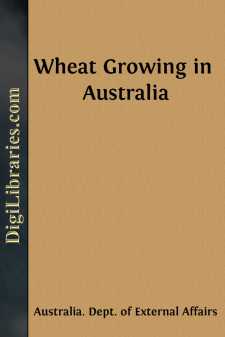Categories
- Antiques & Collectibles 13
- Architecture 36
- Art 48
- Bibles 22
- Biography & Autobiography 813
- Body, Mind & Spirit 138
- Business & Economics 28
- Children's Books 12
- Children's Fiction 9
- Computers 4
- Cooking 94
- Crafts & Hobbies 4
- Drama 346
- Education 46
- Family & Relationships 57
- Fiction 11821
- Games 19
- Gardening 17
- Health & Fitness 34
- History 1377
- House & Home 1
- Humor 147
- Juvenile Fiction 1873
- Juvenile Nonfiction 202
- Language Arts & Disciplines 88
- Law 16
- Literary Collections 686
- Literary Criticism 179
- Mathematics 13
- Medical 41
- Music 40
- Nature 179
- Non-Classifiable 1768
- Performing Arts 7
- Periodicals 1453
- Philosophy 64
- Photography 2
- Poetry 896
- Political Science 203
- Psychology 42
- Reference 154
- Religion 505
- Science 126
- Self-Help 81
- Social Science 81
- Sports & Recreation 34
- Study Aids 3
- Technology & Engineering 59
- Transportation 23
- Travel 463
- True Crime 29
Wheat Growing in Australia
Categories:
Description:
Excerpt
WHEATGROWING IN AUSTRALIA.
With the growing scarcity of foodstuffs that has become a world-wide feature of the last few years, the wheatgrower is one of the most important necessities in civilisation. He has prospered in the past, but the future holds still greater and richer prospects. And in no country in the world are those prospects brighter than in the Commonwealth of Australia. The world's surface is gradually filling up, and most of the older countries have reached sight of the limit of cultivation, so the world's millions have to look to newer lands to provide them with food. The great island continent in the southern seas possesses a vast area of proven wheat land, as yet untouched by the plough. It lies dormant, fertile, and responsive, awaiting the union of labour and land to yield abundance of food.
Breaking up New Ground.Australia has many rural industries, but of agriculture wheat is the most important, just as it is the most important of the world's crops. Wheat is the king of cereals—the prime essential of civilised life. Nearly half the inhabitants of the globe are wheat-eaters. And the number is growing, for the Eastern races are becoming consumers of wheat, which is significant of a higher standard of living. For as races rise in the human scale wheat becomes a more important part of their food. This alone shows the increasing importance of the cereal, and the importance of the men who grow it. Indeed, the food value of wheat, its ease of cultivation and preparation for human use, the fact that it will grow and flourish in so many different soils and climates, and can be made into so many and various products, combined with its quick and bountiful return, all go to enhance the value of wheat grain, and the prospects of the man who grows it.
Science is teaching how to produce more wheat from the same area, is improving the varieties of wheat and the methods of cultivating it, and teaching how to restore impoverished lands. And there is still an enormous area as yet untouched, while land is being utilised now that twenty years ago was deemed incapable of growing wheat. Who can tell what the future will find?
Australia alone has many millions of acres of wheat land as yet unused for that purpose. One of the youngest of nations, yet one of the oldest parts of the world geologically, it can house and feed millions more than its present population. There is room for the extension and continuation of the magnificent progress that wheatgrowing has already made. The story of wheat cultivation is the story of progress. In Australia, within the last decade, wheatgrowing has advanced rapidly. Railways have been built out into new districts, and freight is cheap. Towns have sprung into existence, and the whole aspect of the countryside in district after district being altered by increasing settlement, where wheatfields have taken the place of sheep paddocks. These towns are solvent and prosperous, and certain of a great future, for there is room for immensely greater settlement....



